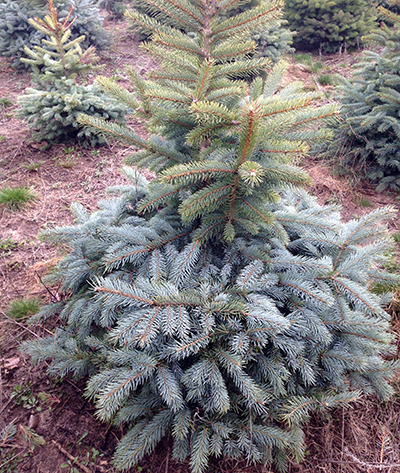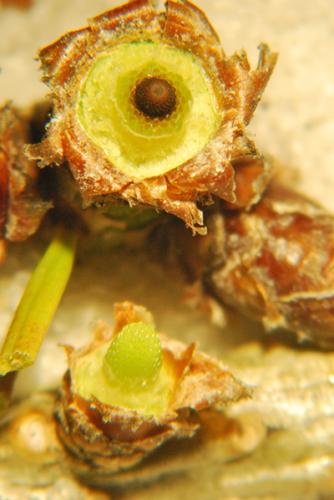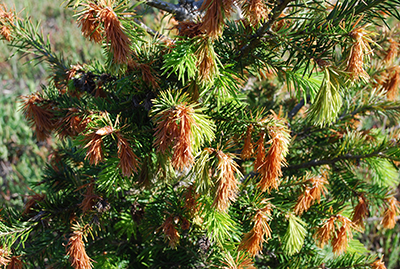Assessing cold injury in conifers
With record low temperatures during winter 2014-2015, many growers are concerned with winter injury on conifers and how to assess damage.

Conifers in Michigan experience winter injury in many forms, including needle, bud and branch injury which can cause tissue browning or death. Winter injury can occur following fluctuations in temperatures during dormancy or during frosts and freezes following bud break. Tree species, seed source, weather conditions and site can all affect the level of cold injury. Michigan State University Extension discusses the following ways growers can assess conifer damage caused by winter injury.
Dormant injury
Loss of cold hardiness is one way conifers can be injured during dormancy. Trees from regions of the world that experience cold temperatures have adapted to withstand varying levels of cold, expressed as cold hardiness. Conifer cold hardiness levels increase as temperatures decline in the fall and builds over time to a maximum level mid-winter. Hardiness then decreases as temperatures slowly warm in late winter. Warm periods during the winter reduce a tree’s cold hardiness and cause winter injury when temperatures drop again. Freezing injury may occur during these temperature fluctuations, potentially causing tree death. Damage from intense sunlight on the southern side of the tree can also cause local damage from a loss of cold hardiness, commonly referred to as “southwest disease.”
Winter injury during tree dormancy can also occur from low humidity, sunny conditions and high winds that desiccate needle, bud and twig tissue causing dehydration, damage and death. Affected needles turn brown and may appear banded or mottled. Injured twigs become brittle and the growth cambium located just below the bark turns green to brown. Injured buds can appear green at first, but if cut horizontally in half they exhibit brown, dead needle primordia in the center just below the bud scales. Injured buds will fail to develop.
Needle damage may occur more commonly than bud injury as buds on some species are protected with a waxy coating and location in the canopy. Snow cover also protects tissue from desiccation, so growers experiencing this form of winter injury may see a pattern of heathy tissue on tree skirts protected by snow cover and symptoms of injury above the snow line.

Blue spruce exhibiting signs of winter injury above the snow line. Photo credit: Erin Lizotte, MSU Extension
Assessing bud damage
Growers can assess vegetative bud damage on their farm by opening and inspecting buds. To ensure a good assessment, collect vegetative buds from the terminal end of the lower, middle and upper branches, as well as from trees on the edges and interior of blocks. If the plantation is located on a slope, make sure to collect samples from all elevations. The more buds assessed, the more confident a grower can be in their damage estimate. Sample size and accuracy should be balanced with the potential loss caused by the destructive sampling required.
Growers should cut the bud with a sharp knife horizontally, about two-thirds of the way down the bud toward the stem or peel away the bud scales to reveal the needle primordia inside. Needle primordia should be a vibrant green color. If the primordia in the center of the bud are black, the bud has been killed and will not produce a shoot. Keep track of how many buds you check and how many are dead – this will give you a ratio or percentage of viable vegetative buds.

Cross-section of bud revealing a damaged bud (upper) and a healthy bud (lower). Photo credit: Jill O’Donnell, MSU Extension
Cold injury after budbreak
Cold damage can also occur as succulent new shoots and needles begin to emerge at bud break. Species that break bud early are exposed to spring temperature fluctuations for a longer period of time, making them more vulnerable to spring cold snaps and more frequent injury. As the tree breaks dormancy and sap begins to flow, shoots and needles begin to expand as the tree rehydrates. At this time, the tree has lost any cold hardiness gained over the winter.
If temperatures drop significantly below freezing for a short period or stay at or just below freezing for an extended period of time, then frost and freeze injury can occur. High winds and temperature inversions can exacerbate this type of cold injury. Cold injury to new shoots can lead to undesirable tree structure over time.

Frost injury to new growth on a Douglas fir. Note the primarily unaffected older growth. Photo credit: Jill O’Donnell, MSU Extension
This material is based upon work supported by the National Institute of Food and Agriculture, U.S. Department of Agriculture, under Agreement No. 2013-41534-21068. Any opinions, findings, conclusions, or recommendations expressed in this publication are those of the author(s) and do not necessarily reflect the view of the U.S. Department of Agriculture.



 Print
Print Email
Email




